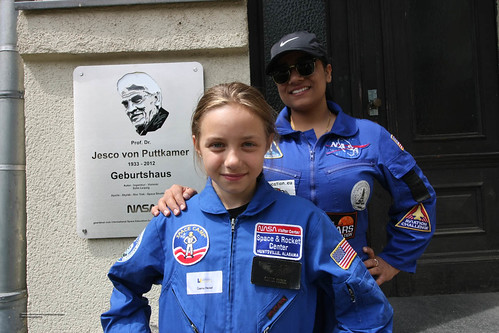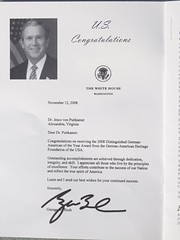| Events - Competitions |
20 Years of the International Space Education Institute
18 Years of International Teams at NASA
April 2nd, 2025 Leipzig/Huntsville, Alabama (ISEI) Cosma Heckel is the pilot of the Rovernauts, preparing herself and her team for the NASA Rover Challenge on April 12th, 2025, and is now 18 years young. Her team includes Leander (15) from Grimma, Luiza (18) from Rio de Janeiro, Hazel (18) from Washington, DC, and the young engineer Jesco (11) from Leipzig. Never before has a team represented so much multinationality. Boundaries are blurring.
At the age of 3 months, Cosma was there for the first time when the first international junior team participated in a NASA competition. It was arranged by her parents, Yvonne and Ralf Heckel, together with Leipzig-born NASA scientist Prof. Dr. Jesco von Puttkamer, who served as Director of the International Space Station (ISS) from 1998 to 2012, said: "If we as humanity want to land on Mars, we must train young people in international cooperation. And that's why I'm committed to ensuring that international teams can participate in this competition. Don't let me hang here!"
Team Germany from the International Space Education Institute in Leipzig, led by Thommy Knabe (then 15, now head of HAFLE- Plastics technology Reichenbach), was the first international team and has already won prizes in Huntsville in April 2007. It was the experiences and reports of these and their subsequent participants that triggered an avalanche of enthusiasm. First 2, then 4, then 8, then 32, but today this competition consists of half international teams, all of whom have their origins in Leipzig's summer camps and their exchange programs around the globe.
Cosma has participated every year, even traveling the world with her father and chairman, explaining the Moonbuggy in several languages. At the age of 7, she was already driving it around Leipzig and helping every team wherever she could. Today, with 15 years of participation (the competition was suspended during the pandemic), she is by far the longest-serving participant/pilot in the NASA Roverchallenge. Their teams can look back on 7 podium finishes, 3 world championship titles, 26 participations and a total of 46 vehicles – that alone is a first.
 Cosma represents her generation in the Leipzig Youth Parliament, the Youth Council of the US Consulate General in Leipzig, and as a training ambassador for skilled trades at HANDWERK (handcraft). Cosma is a prospective industrial mechanic with a high school diploma from 1st Mould in Pirna. Her teammates from previous years are already studying space-engineering or training to become astronauts.
Cosma represents her generation in the Leipzig Youth Parliament, the Youth Council of the US Consulate General in Leipzig, and as a training ambassador for skilled trades at HANDWERK (handcraft). Cosma is a prospective industrial mechanic with a high school diploma from 1st Mould in Pirna. Her teammates from previous years are already studying space-engineering or training to become astronauts.
On April 5th, she will fly to the USA for the last time as a competition participant. She wants to be the first all-girl team on the rover, at least for a complete run. This was a last wish from Jesco von Puttkamer. After that, there are exams, studies, and careers.
The ISEI also sees its mission fulfilled after 18 years of this competition. "We have achieved everything, made the world aware of it, helped shape it, and produced brilliant young scientists. No team can compete with us on this competition course. We're too well-rehearsed for that, and the design has evolved too far over the years of its own evolution. We want to move on, and unfortunately, that's no longer possible here."
ISEI is taking a preliminary farewell tour of several NASA centers with the NASA Rover Challenge team 2025. The young people will once again encounter US and international teams and have the opportunity to prove themselves, meet with astronauts and colleagues of Prof. von Puttkamer in Washington, D.C., and once again, a new generation of students will see a rocket launch at Cape Canaveral. This will be the 12th launch experience in 20 years.
But what's next?
President Ralf Heckel says: "We're celebrating our 20th anniversary this summer. It's time to print these experiences in book form for future generations, to thank our sponsors, and to show that there are no limits and that anything can be achieved when everyone pulls together on one rope."
"We will establish a "Hall of Fame" for the 46 successful Leipzig Moonbuggies and produce with our past drawings a series of electric-powered kits for schools and training workshops around the world, thus launching a new competition in Europe. This is missing here.
We will also leverage our experience and construct inclusion-tandems for Leipzig and Europe, exchange international students, and launch a commercial series for sports, health, and youth. Micromobility has a future not only in space, but especially here on Earth. If it brings even more young people and ideas together, it's worth it."
The International Space Education Institute operates the 2000 sqm Puttkamer Campus in the heart of Leipzig with workshops, laboratories and overnight accommodation for international exchange students.
In 20 years, ISEI produced over 3000 press articles in total 30 countries, 500 TV reports and has an archive of around 300,000 photos documenting this extraordinary work.




 www.SpaceEducation.de
www.SpaceEducation.de
www.nasa.gov/learning-resources/nasa-human-exploration-rover-challenge/
There are no translations available. TV-Reports Foto-Archiv Blog (is in process)
Die damalige Pilotin Firine fuhr den Rover im Alter von 14 Jahren und besuchte ein Jahr zuvor das US-Space Camp, den SpaceX Start des Teleskopes TESS und mit ihrem Team die Embry Riddle University in Daytona, Florida. Heute ist Firine Bugenhagen 19 Jahre alt, studiert im 6. Semester Luft- und Raumfahrt an der TU-Delft und wird ab August dieses Jahres an die Embry Riddle University delegiert. Das ist dann bereits unsere 3. Studentin an dieser Eliteschule, aus der Astronauten und Raumfahrtingenieure hervorgehen. Wie man damit sieht, sind unsere Mitgliedschaft, die Ausbildung und Wettbewerbe nachhaltig und eine gute Vorbereitung für jene die weiterwollen. Das ist auch kein Wunder, denn wir wenden die Empfehlungen vom Prof. Dr. Jesco von Puttkamer an. Ungeplant kam die Pandemie mit dem Reisebann und der Krieg Russlands gegen friedliebende Menschen und die freie Welt dazwischen. Das mühsam aufgebaute immer überlegene multinationale Netz der Brücken zwischen den Nationen und Generationen hängt seitdem auf einer Seite empfindlich in der Luft. Nur schrittweise wird dieses Loch mit Asien, seinen Partnern, seinen Kontakten und Schülern ausgefüllt. Aber auch der Verlust der beständigen gemeinsamen Zusammenarbeit vor Ort führte zu einem Loch der Nachfolgegeneration bei unseren jüngeren Mitgliedern. Virtuelle Unterrichtseinheiten können Praxis, Hands-On und Face-To-Face nicht ersetzen. Die Rovernauts hatten es also während der Pandemie überhaupt nicht leicht. Es wurde mit Mindestbesetzung CAD gelernt, 3D-Druck und die Werkstatt ausgebaut, also das Feuer brennen gelassen. Aber zu einem Mitgliederzuwachs unter der jungen Generation führte das wegen des komplexer gewordenen Schulalltages nicht. Das Sommercamp 2023 war zwar intensiv und es kamen auch einige Schüler aus der Ferne, aber schnell wurde klar, dass das Homeschooling den Nachwuchs von der Praxis entfremdete. Es wurde absehbar, dass sich kein Team für die Konstruktionsanforderungen eins Rovers bilden konnte. Ersatzweise wurde dann 3D-Druck, Modellbau und die Erweiterung der Werkstatt mit Holzbau vermittelt. Das schuf dann eine gute logistische Basis, aber die Gruppe zerstreute sich im ausgehenden Sommer wegen der Entfernungen innerhalb Deutschlands wieder. Erst auf den letzten Pfiff und mit einem Aufruf in Presse und TV gelang es der Teamleiterin Cosma Heckel (heute 17 und zum letzten Rennen nur 12 Jahre jung) noch ein Team mit 2 weiteren Teilnehmern ihrer Berufsschule zusammen zu schweißen. Das passierte erst im Januar 2024, also bereits 6 Monate nachdem andere Teams bereits mit schriftlichen Arbeiten Punkte bei NASA sammelten und fleißig konstruierten. Wegen der beständig fortgeführten Weiterentwicklung zur Pandemie konnte das neue Team Rovernauts 2024 in den Winterferien schnell an Fahrt aufnehmen. Unterstützend standen schnell wieder die Unternehmen Dreherei Günter Jakob, Metallverarbeitung HOLL, Sattlerei Kübler, Sandstrahlerei Doerffer und die Firma Althaus Galvanik und Pulverbeschichtungen dahinter. Vor allem aber gewann das Team schnell Aufwind durch die Unterstützung der Handwerkskammer zu Leipzig und deren Einladung zur Mitteldeutschen Handwerksmesse Leipzig. Hier konnten Besucher begeistert und weitere Mitglieder der jüngeren Generation gewonnen werden. Eine richtige CAD- und Produktionsstraße wurde vor den 50.000 staunenden Messebesuchern betrieben und es konnte mitgemacht und mitgefahren werden. Binnen 10 Wochen konnte im Rekordtempo ein komplett neuer Rover in der seit Sommer 2923 neuen Werkstatt geschaffen werden. Hier half der immense 17-jährige Erfahrungsschatz des Vereines mit 45 gebauten und modifizierten Fahrzeugen genauso wie der erstarkende Erfolgswille des Teams. 2 Ferien gingen komplett drauf. Obwohl das Team bei den schriftlichen Vorbewertungen noch gar nicht mitmachen konnte, entschied man sich für die Fahrt zum Wettbewerb trotz des damit schlechten Scores von 35%. Am Tag der Raumfahrt, also dem 12. April 2024, ging es dann in den Flieger und ein Abenteuer mit 18.000 Flug- und 5.000 Fahr-Kilometern begann. Alle Ereignisse hielten die Teammitglieder in Berichten, Reels und mit Videos fest. Eine Linkliste gibt es oben und unten. Hier sind die Fakten: Die Teammitglieder Frederik Fichtner (17), betreut durch die Jesco von Puttkamer Schule seit 3 Monaten Co-Pilot, Multitool-Bediener, Fachabiturient, Karl-Heine-Schule Heidi Claus (18), betreut durch die Jesco von Puttkamer Schule seit 3 Monaten Fachabiturient, Karl-Heine-Schule, Technikerin, Trainerin Jesco Heckel (10), betreut durch die Jesco von Puttkamer Schule seit 6 Jahren, Grundschüler, 74. Grundschule - dann Gymnasium an der Quartiersschule Ihmelstraße, Techniker, Kameramann, erfahren in CAD und Technik mit Betreuung durch eine Tesla-Ingenieurin Weiblicher Rover namens OPHELIA Technische Daten des Rovers Änderungen seit 2019 Ergebnisse der Rovernauts unter 70 Teams Rovernauts das Team der Herzen Wie lief das Rennen? Das 2. Rennen war ein Gänsehaut-Event. Die beiden durchfuhren den schweren Kurs absolut souverän und perfekt, ohne Fehler und sammelten bei den Aufgaben alle Punkte. Sie trafen mit einem Zeitvorsprung von 3 Minuten! Im Ziel ein. Kein Team war schneller. Teams mit Null Fehlern und 100% Punkten waren 3 Minuten langsamer. Alle Teams und alle Rennställe waren fassungslos und interessierten sich ab diesem Moment für den Rover „Ophelia“ und die beiden Piloten. Zur Belohnung ging es auf NASA-Tour und zum Starship von SpaceX
Blog | Fotogallery | Videochannel | Instagram | Facebook
Arthur speaks about his experiences with us and NASA in schools, universities, conferences, symposiums and also at a cadet college of the Indian Army. The main focus is on the future in space, jobs and career opportunities. He presents these together with his own experiences from the launch of NASA's moon rocket ARTEMIS 1. He explains the individual phases of a launch and flight to the moon using a self-built model (1:87) of the SLS moon rocket. The young and mature audience is always enthusiastic. An overwiev in Fotos. At many appearances he is supported by 16-year-old Cosma Heckel, who is then connected via video conference. The first four weeks seemed much longer to Arthur, "because you experience so much in a short time here." He receives support from his mentor and teacher Navdeep Singh from the World Space Council India. The International Space Education Institute has built up this partnership over the years and supports the current transformation of over 30 countries into space nations with human capital through world trips for schoolchildren and students. Arthur is also a member of the International Space Education Institute's 2024 NASA Human Exploration Rover Challenge accepted team called the Rovernauts. This team has a successful history of 16 years as the first international participant with 3 world championship titles and 44 lunar car-like vehicles in various variations.
As an ambassador for the NASA Artemis Generation, Arthur supports the agency's efforts to promote more science among young people under the name "STEM Engagement".
The world tour, a social year for graduating students, is available to members of the International Space Education Institute to gain global life experiences. This not only creates unforgettable experiences for life, but above all builds bridges across supposed boundaries and gives other students a unifying career vision for the future.
Arthur Sommer from International Space Education Institute, Germany reached Indri Indri, 7 November (Nis) Space science is a wonderful field full of possibilities. It contains the lives of many astronauts and their stories of going to space, ranging from failures to successes. These words were said by Navdeep Singh, President of the World Space Council and Arthur Sommer, member of the International Space Education Institute, Germany. He was addressing as the keynote speaker in a lecture organized on the topic of opportunities in space science under the joint aegis of Employment Cell, Physics Department and Chemistry Department at Shaheed Udham Singh Government College located in village Matak Majri. PICTURE: He taught students about space rocket Navdeep Singh and Arthur Sommer with students and teachers at Shaheed Udham Singh Government College located in Matak Majri village of Indri. Along with telling the methods of making it, also explained the ways to reach NASA. College Principal Dr. Vikas Attri welcomed the guests and called upon the students to take inspiration from such personalities.Dr. Suresh Kumar, in-charge of Placement Cell, coordinated the program and conducted the stage. Dr. Deepa Sharma did it. Arthur Sommer, who came from Germany, shared his NASA experiences with the students. He gave details of the structure of the space rocket and explained the method of making the rocket. Dr. Bohti Dhanda, Dr. Gulab, Dr. Raj Kumar and Dr. Sumit Goyal were present in organizing the program.
Cosma get accreditation as vocational-training ambassador!
The kits, which were laser-cut at the HOLL metalworking company, can now be ordered by any school for learning motor skills at the Leipzig Chamber of Crafts. The fully assembled, creatively designed and upgraded models with 3D-Print and an electric circuit will then be awarded prizes by Cosma and a jury of experts. Prizes and an invitation to the next NASA Rover Challenge in the USA will be awarded. On November 13th the Chamber of Crafts in Leipzig will present Cosmas educational set nationalwide.
(Leipzig 1933, NASA 1962-2012) Happy Birthday Prof. Dr. Jesco von Puttkamer today: 22.9.2022, Leipzig /Huntsville AL /Alexandria VA, International Space Education Institute e.V. On Friday, September 22, 2023, the German-American NASA scientist born at Salomonstr. 25 in Leipzig would celebrate his 90th birthday. His father worked as an editor at the Reclam publishing house and emigrated to Switzerland with his young family after the seizure of power in 1933. After the war, 12-year-old Jesco moved to his grandmother in Bavaria and attended school there. He often spoke of how the starlit Bavarian nights were his inspiration for space. He completed his mechanical engineering studies in Aachen in 1962. He financed his studies as an author of sci-fi paperback novels such as "Galaxis Ahoy" and "The Timemanuskript". After receiving a telegram from America: "Don't go into business, come to Huntsville, we're going to the moon, stop," the young engineer emigrated and worked on the Apollo program. His responsibilities included lunar gravitational anomalies and studies on the reusability of Saturn V stages, from which the space shuttle fleet emerged. His commitment to the Commercial Orbital Transportation Systems (COTS) program comes to impressive heights with SpaceX and other competitors this decade. Never putting aside his pen as an author, von Puttkamer wrote countless non-fiction and technical books on spaceflight as head of the Strategic Planning Division beginning in the 1970s. He also remained loyal to science fiction, advising Gene Roddenberry and Star Trek as a NASA representative and enlisting African-American Nichelle Nichols (known as Lt. Uhura) as an ambassador for NASA youngsters of the 1970s. His family's Slavic roots allowed him a conciliatory mentality with the scientists of the then-Soviet Union in the Apollo-Soyuz program, which, thanks in part to von Puttkamer's driving force after perestroika, resulted in various MIR missions with space shuttle flights and ultimately the construction of the International Space Station (ISS). Von Puttkamer held the post of NASA director for the ISS at Washington headquarters from 1998 until his death in 2012. Despite the Russian war of aggression, the ISS remains to this day a multinational peace ambassador for humanity in space and a guarantor of scientific cooperation. The engineer received various honorary doctorates and professorships for his tireless international work with students, which today already includes several generations of space scientists. In 2005, Prof. Dr. von Puttkamer decided to found a school for the early promotion of young space engineers together with citizens of Leipzig as a support association. At the turn of the millennium, he selected the then young Leipzig couple Yvonne and Ralf Heckel as personal aspirants for this development work. This school has achieved impressive results to date, producing numerous international space scientists, engineers and even aspiring female astronauts. Today, the school bears his name and comprises a small climate and science campus of 2000 m² in the east of Leipzig, not far from the house where he was born. Von Puttkamer received numerous awards. Above all, 2 outstanding honors should be mentioned here. In 2008 von Puttkamer received the title "Distinguished German American" with congratulations from the 43rd US President and NASA. In the same year the Jet Propulsion Laboratory dedicated a newly discovered asteroid between Mars and Jupiter, the "266752 Vonputtkamer". In 2007, von Puttkamer and his Leipzig school opened the gates for the first time for non-U.S. citizens to participate in NASA junior competitions at the NASA Moonbuggy Race (later NASA Roverchallenge). From this more than 100 teams grew up until today and already 3 world championship titles went to Leipzig.
Puttkamer was a visionary who saw the future as a body in front of him and could explain it in an understandable way. Each of his lectures between Moscow and California was an experience. It is as if this future built by him would bow deeply in these weeks, because: 1. valuable hand drawings and manuscripts in poster format from the Apollo period were recently found in the attic of his former home in Huntsville - they will be shown in Leipzig on his birthday. 2. the ISS shows itself on the evening of his birthday over the native city Leipzig at 20 o'clock on 90 degrees over Leipzig with -4,2 Mag particularly bright and close. 3. asteriod 266752 Vonputtkamer is currently in an unprecedented opposition to Earth and could actually be photographed by the institute's own self-built observatory 7 days ago at a distance of 150 million km (distance Earth-Sun) despite its small size and light faintness of -20 mag. It is currently found to the west of Jupiter between Aries and Pisces (the photos will be presented on Sept 22, 2023 for the birthday). 4. NASA and DLR sealed the return to the Moon last week by joining the Artemis program. 5. the first European young talents who were allowed to accompany an Artemis launch as VIP visitors are from Leipzig. They are 3 students aged between 8-18 years. 6. the COTS program of the NASA experienced a momentum of its own, so that now to the birthday the largest ever built moon rocket stands ready for takeoff on the test launch site in Boca Chica Texas. It is Elon Musk's Starship and a visualization of Puttkamer's vision. 7. the management of the Jesco von Puttkamer School already accompanied the first launch of the Starship on April 20, 2023 and is now opening educational tours to subsequent launches. 8. all over the world former "Puttkamer students" are involved in space missions and moon missions. This ranges from India to Leipzig to California. Since 2018, the Jesco von Puttkamer School also has a branch in India. A delegation from India is currently visiting Leipzig. Prof. Dr. Jesco von Puttkamer was the NASA face on German TV for over 50 years. His "children" now dominate social media with educational partners in over 30 countries, driving our future forward. He himself was never in space, but described himself as a "desk astronaut" and in his last book described the "millennium project Mars" and the landing of man on it. Today, he is commemorated by a plaque at the house where he was born in Leipzig and a plaque at his home in Huntsville, Alabama. Vor allem aber lebt im steten Raumfahrt-Nachwuchs aus der Leipziger Schule mit seinem Namen sein Lebenswerk fort. Für diesen 90. Geburtstag wurde in diesem Jahr beträchtlich in die Schule investiert in Hauptgebäude, Außenbereich und Werkstätten. Machen Sie sich selbst ein Bild. Those interested in lectures, talks, reminiscences and, above all, the future are very welcome. The program on 22.9.2023: The program afterwards: Contact: Contact person: Registration for the birthday party is required via WhatsApp. Admission is free, but birthday gifts are expected in the spirit of the professor after his words: "This youth must be actively supported. This is our debt to bring!" Birthday gifts please to the donation account: This e-mail address is being protected from spambots. You need JavaScript enabled to view it or in the following currencies in the next months and years to continue Puttkamers life's work: - time - commitment - ideas - and also money |

































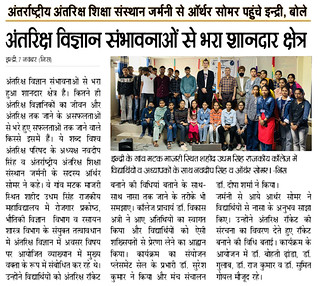





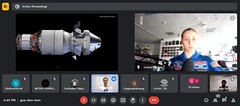
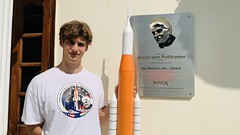
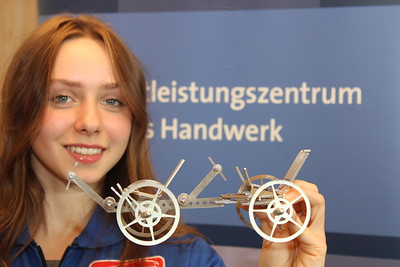

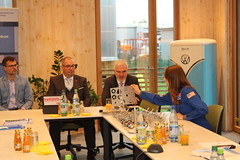
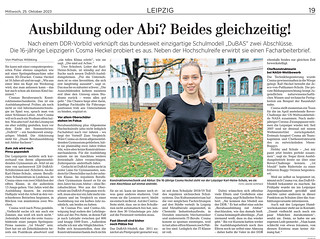 The occasion was today's appointment of Cosma as an ambassador for training in the craft, made by the President Mr. Matthias Forßbohm, the Chief Executive Mr. Volker Lux and the press officer Dr. Andrea Wolter, the Chamber of Crafts Leipzig. This happened during the press conference of the Chamber of Crafts for the publication of the economic figures and the start of a special program for career orientation in schools in which Cosma plays a leading role with her self-modified 1:10 models of the Moonbuggys.
The occasion was today's appointment of Cosma as an ambassador for training in the craft, made by the President Mr. Matthias Forßbohm, the Chief Executive Mr. Volker Lux and the press officer Dr. Andrea Wolter, the Chamber of Crafts Leipzig. This happened during the press conference of the Chamber of Crafts for the publication of the economic figures and the start of a special program for career orientation in schools in which Cosma plays a leading role with her self-modified 1:10 models of the Moonbuggys.






